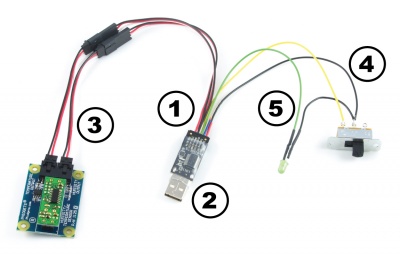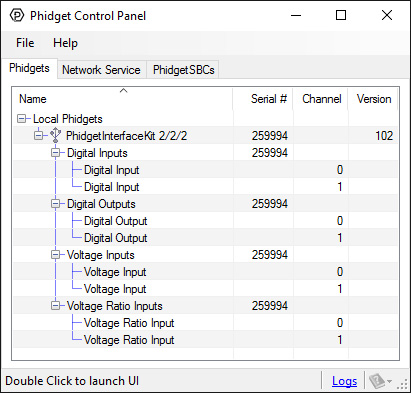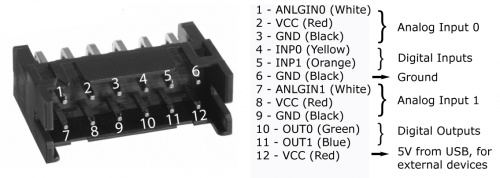1011 User Guide: Difference between revisions
No edit summary |
|||
| Line 66: | Line 66: | ||
{{UGnext|}} | {{UGnext|}} | ||
Revision as of 14:19, 16 September 2016
Required Hardware
- A 1011 Phidget InterfaceKit and connector cable
- Sensors, LEDs, and switches to test the InterfaceKit
- A computer
Connecting the Pieces

- Plug the connector cable into the 1011 Phidget InterfaceKit.
- Connect the sensors, LEDs, and switches to the appropriate cables on the connector. For details, see the technical section.
- Plug the Phidget into one of your computer's USB ports.
Testing Using Windows
Phidget Control Panel
In order to demonstrate the functionality of the 1011, the Phidget Control Panel running on a Windows machine will be used.
The Phidget Control Panel is available for use on both macOS and Windows machines.
Windows
To open the Phidget Control Panel on Windows, find the ![]() icon in the taskbar. If it is not there, open up the start menu and search for Phidget Control Panel
icon in the taskbar. If it is not there, open up the start menu and search for Phidget Control Panel
macOS
To open the Phidget Control Panel on macOS, open Finder and navigate to the Phidget Control Panel in the Applications list. Double click on the ![]() icon to bring up the Phidget Control Panel.
icon to bring up the Phidget Control Panel.
For more information, take a look at the getting started guide for your operating system:
Linux users can follow the getting started with Linux guide and continue reading here for more information about the 1011.
First Look
After plugging the 1011 into your computer and opening the Phidget Control Panel, you will see something like this:

The Phidget Control Panel will list all connected Phidgets and associated objects, as well as the following information:
- Serial number: allows you to differentiate between similar Phidgets.
- Channel: allows you to differentiate between similar objects on a Phidget.
- Version number: corresponds to the firmware version your Phidget is running. If your Phidget is listed in red, your firmware is out of date. Update the firmware by double-clicking the entry.
The Phidget Control Panel can also be used to test your device. Double-clicking on an object will open an example.
Voltage Input
Double-click on a Voltage Input object in order to run the example: [[Image:{{{1}}}_VoltageInputSensor_Example.jpg|center|link=]]
General information about the selected object will be displayed at the top of the window. You can also experiment with the following functionality:
- Modify the change trigger and/or data interval value by dragging the sliders. For more information on these settings, see the data interval/change trigger page.
- If you have an analog sensor connected that you bought from us, you can select it from the Sensor Type drop-down menu. The example will then convert the voltage into a more meaningful value based on your sensor, with units included, and display it beside the Sensor Value label. Converting voltage to a Sensor Value is not specific to this example, it is handled by the Phidget libraries, with functions you have access to when you begin developing!
For more information about Voltage Inputs, check out the Voltage Input Primer.
Voltage Ratio Input
Double-click on a Voltage Ratio Input object in order to run the example: [[Image:{{{1}}}_VoltageRatioSensor_Example.jpg|link=|center]]
General information about the selected object will be displayed at the top of the window. You can also experiment with the following functionality:
- The voltage ratio is reported in Volts per Volt. For example, if the Phidget is providing 5V and the sensor is sending back 2.5V, the ratio will be 0.5V/V.
- Modify the change trigger and/or data interval value by dragging the sliders. For more information on these settings, see the data interval/change trigger page.
- If you have an analog sensor connected that you bought from us, you can select it from the Sensor Type drop-down menu. The example will then convert the voltage into a more meaningful value based on your sensor, with units included, and display it beside the Sensor Value label. Converting voltage to a Sensor Value is not specific to this example, it is handled by the Phidget libraries, with functions you have access to when you begin developing!
For more information about Voltage Ratio Inputs, check out the Voltage Ratio Input Primer.
Digital Output
Double-click on a Digital Output object {{{2}}} in order to run the example: [[Image:{{{1}}}_DigitalOutput_Example.jpg|center|link=]]
General information about the selected object will be displayed at the top of the window. You can also experiment with the following functionality:
- Toggle the state of the digital output by pressing the button.
Testing Using macOS
- Go to the Quick Downloads section on the macOS page.
- Download and run the Phidget macOS Installer
- Click on System Preferences >> Phidgets (under Other) to activate the Preference Pane
- Make sure your device is properly attached
- Double click on your device's objects in the listing to open them. The Preference Pane and examples will function very similarly to the ones described above in the Windows section.
Testing Using Linux
For a general step-by-step guide on getting Phidgets running on Linux, see the Linux page.
Using a Remote OS
We recommend testing your Phidget on a desktop OS before moving on to remote OS. Once you've tested your Phidget, you can go to the PhidgetSBC, or iOS pages to learn how to proceed.
Technical Details
I/O Wiring Diagram

Replacing the I/O Interface Cable
If your I/O interface cable gets damaged, you can remove it and replace it with 3013 - PhidgetInterfaceKit 2/2/2 Replacement Cable. Pull hard on the connector until it comes out.
You can also remove individual wires from the cable if they are not needed. Detach the wire assembly from the 1011, delicately pry up the plastic tab with a small flat-head screwdriver, and pull out the wire. This should only be done for wires that you never plan on needing as it is very easy to break the plastic tab.
Warning: The cable has been designed to be permanently attached to the 1011. We strongly recommend that you limit the number of times you remove the wire assembly from the 1011 to as few times as possible since repeated removals and insertions will eventually damage both connectors.
These connectors are commonly available- their part numbers are listed below. For part numbers on the analog sensor cables, see the mechanical section of the Analog Input Primer.
| Manufacturer | Part Number | Description |
|---|---|---|
| Hirose Electric | DF11-12DP-2DS(24) | 2mm Double-Row Connector (Right Angle Pin Header) |
| Hirose Electric | DF11-12DS-2C | 2mm Double-Row Connector (Crimping Socket) |
Note: Most of the above components can be bought at www.digikey.com.
Further Reading
If you want to know more about the input/output capabilities of the 1011 InterfaceKit, check the Digital Input Primer, Digital Output Primer, and the Analog Input Primer.
What to do Next
- Programming Languages - Find your preferred programming language here and learn how to write your own code with Phidgets!
- Phidget Programming Basics - Once you have set up Phidgets to work with your programming environment, we recommend you read our page on to learn the fundamentals of programming with Phidgets.
